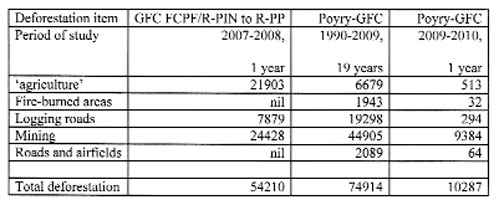Almost nine per cent of Guyana’s budget this year hangs on the Poyry-Guyana Forestry Commission
-----------------
Almost nine per cent of the government’s planned expenditure in the 2011 national budget depends upon receipt of US$70M from Norway, under the MoU signed on November 9, 2009. That is surely a risky strategy because there appears to be no fall-back position if the Norwegian money does not come, or not in that quantity. So achievement of the progress indicators (‘enablers’ in Norwegian terms) is a major test.
Some of these indicators are related to the amounts of intact forest and rates of deforestation, although Guyana has made no explicit commitment to reduce its emissions of forest carbon (which I estimated in 2009 at 11.4 million tonnes for 2007-8, using data from the Guyana Forestry Commission*).
Poyry New Zealand was the selected consultant to re-estimate forest areas and deforestation, a draft report was posted by the GFC in October 2010 (and is still on the LCDS website www.lcds.gov.gy) and a second version was posted in mid-January. Norwegian Veritas has won the contract to verify the Poyry findings and a report on that is due in mid-March 2011.
Meanwhile, a 4-person mission from the Government of Norway is in Guyana in the first week of February and perhaps citizens may wish to contact them about the unusual features of the joint Poyry-GFC report.
In order to meet the Norwegian conditions, it is in the interest of Guyana to convince the Nordics that its deforestation is very small relative to its forest area. The Poyry-GFC report contains such curious statements as:
Page 87: “Industrial-scale exploitation of timber… is not practiced in Guyana in the period under review” (1990-2010). That seems a strange claim when more than 550,000m3 of timber were reported as produced in 2000 and 2006 (including logs for Barama’s plywood mill), and even 513,000 m3 in the low year of 2009; as well as booming exports of unprocessed logs almost all for manufacture in Asia (over 99,000 m3 in the 11 months to November 2010).
One of the conditions for Norwegian money is that “The total area of intact forest landscapes within the country should remain constant. Any loss of intact forest landscapes shall be accounted as deforestation with full carbon loss.” The MoU uses the standard definition of an intact forest landscape (IFL): a territory within today’s global extent of forest cover which contains forest and non-forest ecosystems minimally influenced by human economic activity, with an area of at least 500 km2 (50,000 ha) and a minimal width of 10 km (measured as the diameter of a circle that is entirely inscribed within the boundaries of the territory).
The definition is qualified by admission of some “[which are] Areas with evidence of low-intensity and old disturbances are treated as subject to ‘background’ influence and are eligible for inclusion in an IFL. Sources of background influence include local shifting cultivation activities, diffuse grazing by domestic animals, low-intensity selective logging, and hunting.” The GFC claims that for the logging concessions which it administers “Harvesting in managed forest areas is small-scale and selective,” contrary to the findings of the Edinburgh Centre for Tropical Forestry, SGS Qualifor, and even the GFC itself (in surveys which showed the heterogeneity of logging, with areas unharvested at all being mixed with areas severely over-harvested in ‘reefs’ of high-value timber). Thus the GFC’s inclusion of the heterogeneously logged areas does not meet the intact forest definition and qualifier, and the 3.8 million ha of TSAs should have been excluded from the claimed 10.2 million ha of IFL on page 83 of the Poyry report.
It is, moreover inconsistent to include the TSA logging concessions within “intact forest landscapes” but to exclude “Historical and current mining areas including allocated concessions and the associated infrastructure from 1990 to 30 September 2010” (page 87). Page 40: “In Guyana’s context forest areas under SFM [sustainable forest management] that adhere to forest code of practice would not be considered deforested as they have the ability to regain elected crown cover threshold.” This implies that the 24 logging concessions with long-term (25 years) licences covering 3.8 million ha are excluded from the deforestation count, no matter how bad is their actual fieldwork, because the GFC does not publish which of those concessions are obliged by the terms of their TSA licences to comply with the otherwise voluntary Code of Practice for Timber Harvesting (second edition, November 2002).
Perhaps the most extraordinary feature of the Poyry-GFC report is the complete absence of reference to the GFC estimates made repeatedly to the World Bank’s Forest Carbon Partnership Facility (FCPF) that in 2007-8 there were 54,000 ha deforested. The table shows the tremendous and unexplained discrepancies between the current and previous GFC estimates. There are plenty more oddities in this report, such as the total absence of cross-checks with the supposedly intensive GFC records for forest management planning, mapping of annual logging areas and timber-tagged production. On this Poyry-GFC report hangs, in part, almost 9 per cent of Guyana’s budget this year. Worth a close look by citizens of Guyana, and the taxpayers of Norway?
* Series of 10 articles on ‘Carbon in the forests of Guyana,’ published by Stabroek News during July-August 2009.
Yours faithfully,
Janette Bulkan
---------------

